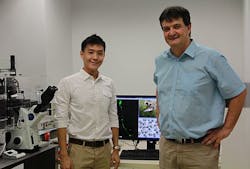Laser imaging of zebrafish model could lead to treatment for human neurodegenerative disease
A team of scientists from the National University of Singapore (NUS) and the University of Würzburg (Germany), using a laser imaging technique, has discovered a possible new route for treating spinal muscular atrophy (SMA), a neurodegenerative disease that is the most common genetic cause of infant death and that also affects young adults. SMA attacks motor neurons in the spinal cord and has been found to be caused by a defect in the SMN gene, a widely used gene that is responsible for normal motor functions in the body.
Also using global genome analysis, the research team, led by associate professor Christoph Winkler of the Department of Biological Sciences at the NUS Faculty of Science, and Dr. Kelvin See, a former A*STAR graduate scholar in NUS who is currently a research fellow at the Genome Institute of Singapore (GIS), found that deficiency in the SMN gene impairs the function of the Neurexin2 gene. This in turn limits the neurotransmitter release required for the normal function of nerve cells. The degeneration of motor neurons in the spinal cord causes SMA. This is the first time that scientists establish an association between Neurexin2 and SMA.
Preliminary experimental data also showed that a restoration of Neurexin2 activity can partially recover neuron function in SMN-deficient zebrafish, indicating a possible new direction for therapy of neurodegeneration. To study how defects in SMN cause neuron degeneration, the scientists utilized a zebrafish model, as the small fish has a relatively simple nervous system that allows detailed imaging of neuron behavior.
In laboratory experiments, the researchers showed when SMN activity in zebrafish was reduced to levels found in human SMA patients, Neurexin2 function was impaired. This novel disease mechanism was also discovered in other in vivo models, suggesting that it is applicable to mammals and possibly human patients.
When the scientists measured the activity of nerve cells in zebrafish using laser imaging, they found that nerve cells deficient for Neurexin2 or SMN could not be activated to the same level as healthy nerve cells. This impairment consequently led to the reduction of muscular activity. Interestingly, preliminary data showed that a restoration of Neurexin2 activity can partially recover neuron function in SMN deficient zebrafish.
âThese findings significantly advance our understanding of how the loss of SMN leads to neurodegeneration," explains Winkler. "A better understanding of these mechanisms will lead to novel therapeutic strategies that could aim at restoring and maintaining functions in deficient nerve cells of SMA patients.â
Dr See added, âOur study provides a link between SMN deficiency and its effects on a critical gene important for neuronal function. It would be interesting to perform follow up studies in clinical samples to further investigate the role of Neurexin2 in SMA pathophysiology.â
Moving forward, the team of scientists will conduct further research to determine whether Neurexin2 is an exclusive mediator of SMN-induced defects and can be used as a target for future drug designs. They hope their findings will contribute towards treatment of neurodegeneration.
Full details of the work appear in the journal Human Molecular Genetics; for more information, please visit http://hmg.oxfordjournals.org/content/early/2013/11/25/hmg.ddt567.abstract?sid=27d8438a-2d77-411a-a2bb-4c78b81c48af.
-----
Follow us on Twitter, 'like' us on Facebook, and join our group on LinkedIn
Subscribe now to BioOptics World magazine; it's free!

